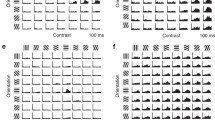Summary
The sensitivity to stimulus orientation — orientation selectivity — of simple and complex neurons in cat striate cortex was studied quantitatively. Orientation selectivity was found to be related to receptive field size — neurons with larger receptive fields being less sensitive to stimulus orientation than those with smaller receptive fields. Simple cells were more orientationally selective than complex cells. The orientation selectivity of simple cells was only weakly related to their receptive field geometry (i.e., receptive field width/length ratio), but simple cells with narrow, elongated excitatory receptive fields are more orientationally selective than those with squarer, excitatory receptive fields. These results indicate that orientation selectivity cannot be accounted for solely by the geometry of the excitatory zones and suggest that inhibitory influences sharpen the tuning of simple striate neurons for stimulus orientation.
Similar content being viewed by others
References
Andriessen, J.J., Bouma, H.: Just noticeable differences in slant of test lines as a function of retinal eccentricity. IPO Annual Progress Report 5, 110–113 (1970)
Berkley, M.A.: Line orientation discrimination deficits following partial ablation of the geniculo-cortical system in cats. Society of Neuroscience, Washington, D.C. (1971)
Bishop, P.O., Burke, W., Davis, R.: The identification of single units in central visual pathways. J. Physiol. (Lond.) 162, 409–431 (1962)
Bishop, P.O., Coombs, J.S., Henry, G.H.: Interaction effects of visual contours on the discharge frequency of simple striate neurones. J. Physiol. (Lond.) 219, 659–687 (1971a)
Bishop, P.O., Coombs, J.S., Henry, G.H.: Responses to visual contours: spatio-temporal aspects of excitation in the receptive fields of simple striate neurones. J. Physiol. (Lond.) 219, 625–657 (1971b)
Bishop, P.O., Dreher, B., Henry, G.H.: Stimulus specificities of the discharge centre in the receptive field of simple striate neurones in the cat. J. Physiol. (Lond.) 218, 53–55 (1971c)
Campbell, F.W., Cleland, B.G., Cooper, G.F., Enroth-Cugell, C.: The angular selectivity of visual cortical cells to moving gratings. J. Physiol. (Lond.) 198, 237–250 (1968)
Creutzfeldt, O., Ito, M.: Functional synaptic organization of primary visual cortex neurones in the cat. Exp. Brain Res. 6, 324–352 (1968)
Fernald, R., Chase, R.: An improved method for plotting retinal landmarks and focusing the eyes. Vision Res. 11, 95–96 (1971)
Henry, G.H., Bishop, P.O.: Simple cells of the striate cortex. In: Neff, W.D. (ed.), Contributions to Sensory Physiology. Vol. 5, pp. 1–46. New York: Academic Press 1971
Hoffman, K.-P., Stone, J.: Conduction velocity of afferents to cat visual cortex: a correlation with cortical receptive field properties. Brain Res. 32, 460–466 (1971)
Hubel, D.H.: Tungsten microelectrode for recording from single units. Science 125, 549–550 (1957)
Hubel, D.H.: Single unit activity in the lateral geniculate body and optic tract of unrestrained cats. J. Physiol. (Lond.) 150, 91–104 (1960)
Hubel, D.H., Wiesel, T.N.: Receptive fields of single neurones in the cat's striate cortex. J. Physiol. (Lond.) 148, 574–591 (1959)
Hubel, D.H., Wiesel, T.N.: Receptive fields, binocular interaction and functional architecture in the cat's visual cortex. J. Physiol. (Lond.) 160, 106–154 (1962)
Hubel, D.H., Wiesel, T.N.: Receptive fields and functional architecture in two non-striate visual areas (18 and 19) of the cat. J. Neurophysiol. 28, 229–289 (1965)
Hubel, D.H., Wiesel, T.N.: Receptive fields and functional architecture of monkey striate cortex. J. Physiol. (Lond.) 195, 215–243 (1968)
Muir, D., Over, R.: Tilt aftereffects in central and peripheral vision. J. exp. Psychol. 85, 165–170 (1970)
Noda, H., Freeman, R.B., Gies, B., Creutzfeldt, O.D.: Neuronal responses in the visual cortex of awake cats to stationary and moving targets. Exp. Brain Res. 12, 389–405 (1971)
Pettigrew, J.D., Nikara, T., Bishop, P.O.: Responses to moving slits by single units in cat striate cortex. Exp. Brain Res. 6, 373–390 (1968)
Siegel, S.: Non-parametric Statistics, p. 284. New York: McGraw-Hill Book 1956
Vakkur, G.J., Bishop, P.O., Kozak, W.: Visual optics in the cat, including posterior nodal distance and retinal landmarks. Vision Res. 3, 289–314 (1963)
Author information
Authors and Affiliations
Rights and permissions
About this article
Cite this article
Watkins, D.W., Berkley, M.A. The orientation selectivity of single neurons in cat striate cortex. Exp Brain Res 19, 433–446 (1974). https://doi.org/10.1007/BF00234465
Received:
Issue Date:
DOI: https://doi.org/10.1007/BF00234465




